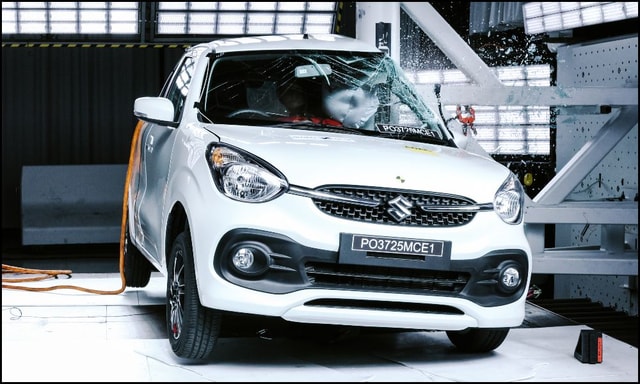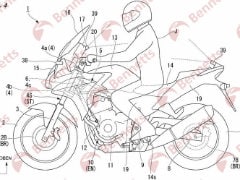Honda Patents Reveal Mind-Reading Motorcycle Tech

- Honda's brain-wave detection patents could revolutionise motorcycle tech
- Brain Machine Interface (BMI) uses rider's brain waves for rider aids
- The system is designed to help riders with less experience avoid crashes
Honda has filed patents for new technology which shows that the Japanese giant is working on a bran-wave detection system to help future motorcycles understand and know their rider's intentions. The idea is to help onboard safety systems ensure the bike does what the rider wants, even if the actual rider control inputs are not accurate, and help avoid a potential serious crash. The new patent application was filed with the US Patent and Trademark Office by Honda's Los Angeles based R&D facility, and it aims to improve the way man and motorcycle interact.
Also Read: Kawasaki Patents Radar Assisted Safety System

The BMI interprets brain-wave signals through built-in electrodes in a helmet, and then sends those signals to the bike.
The system is built around what Honda calls a "Brain-Machine Interface" computer that interprets brain-wave signals through built-in electrodes in a helmet, and then sends those signals to the bike. The motorcycle is equipped with all the contemporary electronic rider-aids available with any high-end premium bike.
Also Read: Patents Reveal Radar Technology For New Honda Gold Wing
So, it has the customary inertial measurement unit (IMU) which measures lean angles and the motorcycle's dynamics, along with computer-controlled lean-sensitive traction control and anti-lock braking system (ABS), and electronic ride-by-wire throttle. The only additional feature will be a sensor measuring steering angle and an actuator to move the steering itself if the on-board computer decides the rider's steering input is not enough and electronic steering intervention is required.
Also Read: Ducati Multistrada V4 With Front & Rear Radar Rolls Out Of Bologna

Honda uses the demonstration of a wheelie to showcase how the BMI works in providing electronic rider aids
Honda actually uses the example of a wheelie and stoppie as examples of the rider's mind and intention to carry out such manoeuvres. While we at carandbike condone pulling such stunts on public roads, there's of course a sense of immense satisfaction at being able to pull off a near perfect wheelie. And it takes a lot of practice, experience and skill, to be able to pull off a perfect wheelie. According to the patent, in such instances, when the rider is getting ready to pull a wheelie, the bike could sense inputs, including brain waves, which may be "indicative of the user's intent to perform the wheelie" and actually assist the rider by taking over control of various aspects of the bike automatically.
Also Read: 2021 BMW R 1250 RT Revealed With Radar Cruise Control
More importantly though, the BMI could act like electronic training wheels for riders with less experience, and even help avoid serious crashes due to inexperience. And according to the text accompanying the patent filing, the BMI can even adapt to an individual's skill level, and gradually offer less electronic compensation as the rider begins to get more riding experience and improve his riding skills and corresponding inputs to the motorcycle.
Trending News
 3 mins readWill The Kawasaki W230 Be Launched In India?
3 mins readWill The Kawasaki W230 Be Launched In India?
Latest News
 car&bike Team | Dec 23, 2025India Bike Week 2025 In Pictures: Highlights From Edition 12The 12th Edition of IBW was held on December 19 and 20, and if you missed this year’s festival, here is a recap of all that happened.3 mins read
car&bike Team | Dec 23, 2025India Bike Week 2025 In Pictures: Highlights From Edition 12The 12th Edition of IBW was held on December 19 and 20, and if you missed this year’s festival, here is a recap of all that happened.3 mins read Amaan Ahmed | Dec 23, 2025Tata To Enter Rs 40 Lakh Passenger Car Market With First Avinya Electric SUV In End-2026Set to be one of three EV launches from Tata Motors next year, the first in the Avinya series of electric vehicles will catapult the Pune-based carmaker into uncharted market territory, as it will be the most expensive Tata yet.1 min read
Amaan Ahmed | Dec 23, 2025Tata To Enter Rs 40 Lakh Passenger Car Market With First Avinya Electric SUV In End-2026Set to be one of three EV launches from Tata Motors next year, the first in the Avinya series of electric vehicles will catapult the Pune-based carmaker into uncharted market territory, as it will be the most expensive Tata yet.1 min read car&bike Team | Dec 23, 2025Will The Kawasaki W230 Be Launched In India?Kawasaki India has teased the W230 on its Instagram handle, indicating that the Kawasaki W230 may be in consideration for a launch in India.3 mins read
car&bike Team | Dec 23, 2025Will The Kawasaki W230 Be Launched In India?Kawasaki India has teased the W230 on its Instagram handle, indicating that the Kawasaki W230 may be in consideration for a launch in India.3 mins read Jaiveer Mehra | Dec 23, 2025Suzuki Fronx Secures One Star Safety Rating In ANCAP Crash Tests As Rear Seatbelt Fails During TestingThe Fronx scored less than 50 per cent points in both, adult and child occupant protection categories.1 min read
Jaiveer Mehra | Dec 23, 2025Suzuki Fronx Secures One Star Safety Rating In ANCAP Crash Tests As Rear Seatbelt Fails During TestingThe Fronx scored less than 50 per cent points in both, adult and child occupant protection categories.1 min read car&bike Team | Dec 23, 2025Final Jaguar F-Pace Rolls Of The Line: Production EndsThe Jaguar F-Pace marks the end of the brand’s internal combustion lineup, as the final model rolls off the line.2 mins read
car&bike Team | Dec 23, 2025Final Jaguar F-Pace Rolls Of The Line: Production EndsThe Jaguar F-Pace marks the end of the brand’s internal combustion lineup, as the final model rolls off the line.2 mins read car&bike Team | Dec 22, 2025Maruti Suzuki Celerio Secures Three-Star Rating In Global NCAP Crash TestsSix airbags-equipped model secured a three-star adult and two-star child occupant protection rating; the dual airbag model scored a two-star rating.3 mins read
car&bike Team | Dec 22, 2025Maruti Suzuki Celerio Secures Three-Star Rating In Global NCAP Crash TestsSix airbags-equipped model secured a three-star adult and two-star child occupant protection rating; the dual airbag model scored a two-star rating.3 mins read
 Seshan Vijayraghvan | Dec 23, 20252026 Kia Seltos Review: Formula Is Spot On, But Is The Timing Right?The 2nd-gen Kia Seltos has arrived, but it has the challenge of facing strong rivals like the Victoris and Sierra. The question is simple - Does it still have what it takes?9 mins read
Seshan Vijayraghvan | Dec 23, 20252026 Kia Seltos Review: Formula Is Spot On, But Is The Timing Right?The 2nd-gen Kia Seltos has arrived, but it has the challenge of facing strong rivals like the Victoris and Sierra. The question is simple - Does it still have what it takes?9 mins read Seshan Vijayraghvan | Dec 22, 20252026 Tata Harrier & Safari 1.5 Hyperion Review: By The Power Of Petrol!The new Tata Harrier and Safari petrol packs a new 1.5-litre TGDI Hyperion engine, but is it an ideal alternative to the diesel version?7 mins read
Seshan Vijayraghvan | Dec 22, 20252026 Tata Harrier & Safari 1.5 Hyperion Review: By The Power Of Petrol!The new Tata Harrier and Safari petrol packs a new 1.5-litre TGDI Hyperion engine, but is it an ideal alternative to the diesel version?7 mins read Bilal Firfiray | Dec 19, 2025Maruti Suzuki e-Vitara Review: Worth The Wait?After a long wait, the first-ever electric Maruti Suzuki is here. It’s the e-Vitara, and it comes with a few promises. But arriving this late, is it worth the wait? Or is it a case of too little, too late?9 mins read
Bilal Firfiray | Dec 19, 2025Maruti Suzuki e-Vitara Review: Worth The Wait?After a long wait, the first-ever electric Maruti Suzuki is here. It’s the e-Vitara, and it comes with a few promises. But arriving this late, is it worth the wait? Or is it a case of too little, too late?9 mins read Bilal Firfiray | Dec 18, 2025Mercedes-Benz G450d: The Subtle Power of EvolutionThe Mercedes-Benz G 450d evolves subtly with more power, improved efficiency, and modern tech, while staying true to the timeless G-Class design. And character.4 mins read
Bilal Firfiray | Dec 18, 2025Mercedes-Benz G450d: The Subtle Power of EvolutionThe Mercedes-Benz G 450d evolves subtly with more power, improved efficiency, and modern tech, while staying true to the timeless G-Class design. And character.4 mins read Janak Sorap | Dec 11, 2025Harley-Davidson X440 T First Ride Review: Smarter and SharperHarley-Davidson has taken the X440 and given it a more focused and engaging twist. The result is the X440 T—essentially the same platform but updated in areas that give the motorcycle more appeal and riders more thrill.5 mins read
Janak Sorap | Dec 11, 2025Harley-Davidson X440 T First Ride Review: Smarter and SharperHarley-Davidson has taken the X440 and given it a more focused and engaging twist. The result is the X440 T—essentially the same platform but updated in areas that give the motorcycle more appeal and riders more thrill.5 mins read




























































































































































